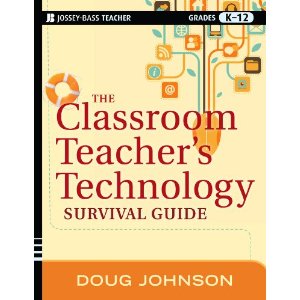GoogleApps and librarians
Head for the Edge, Library Media Connection, May/June 2011
Doug Johnson doug0077@gmail.com
…more than 10 million students, staff, faculty and alumni … are actively using Apps for Education - The Official Google Blog, 10/14/2010 <http://tinyurl.com/37xefq8>
Ever heard these?
- I lost my flash-drive with my homework on it.
- Our computer at home has a different software version than the computers at school so I can’t open my file.
- I was at my grandma’s house last night and my files weren’t on her computer.
- I can’t remember where I put my project.
- I ran out of storage space on my virtual drive.
- My computer’s hard drive failed and I lost my files.
One area in which kids don’t lack creativity is in excuse-making. As a student myself, I was pretty good at finding novel, yet believable reasons why my paper wasn’t finished on time. And this was before there was technology to blame, just that poor old homework-eating dog.
Yet given the unreliable, fast-changing and often confusing nature of technology, the reasons given above for students not completing or having access to their digital work are too often legitimate. These aren’t excuses; they’re real reasons.
By giving students and staff GoogleApps for Education accounts, our school district, like many, hopes to minimize such frustrations. GoogleApps provides at no cost to the district e-mail accounts, shared calendars, a mailing list generator, an to-do list and address book for all staff and students. As powerfully, it provides word processing, spreadsheet, and presentation programs that require only a web browser to access and use. The files created, like the applications themselves, are stored “in the cloud” where can be easily shared, collaboratively edited, and published. [See Libraries in the Cloud in this issue.]
These tools and the files they create are available anywhere, at any time, from any computer that has an Internet connection - Windows, Mac or Linux. No software other than a good web browser is needed.
By providing these cloud-based productivity tools and storage space, the district’s goals are:
- To give our students practice in using current communication and time-management technology applications.
- To give students access to common, no-cost tools both at school and outside of school.
- To facilitate the paperless transfer of work between students and teachers.
- To provide adequate (seven gigabyte as of this writing) long-term storage space for student and staff work.
- To help students and staff work collaboratively, engage in peer-editing of documents, and publish for a wider audience.
In rolling out GoogleApps for Education to our students this year, our school librarians have played a critical role. Here are seven opportunities “GoogleApps” implementation presented to our building’s “information literacy” experts:
- This is our chance to be technology gurus - again! We are not just teaching face-to-face staff development classes, but we serve as role models by sharing documents, collaborating, and using these tools as teachers ourselves. One doesn’t need to know much to be the “expert” in your school on GoogleApps - just be about five minutes ahead of everyone else* Such a reputation in a building is gold.
- We teach students these tools as part of our information and technology curriculum, using GoogleDocs for activities we would have used desktop programs for in the past. We have also accepted major responsibility for helping students use these new resources safely and responsibly.
- We create templates and tools to help students during the research process. We are finding GoogleApps less cumbersome than managing separate wikis, blogs, and other independent online tools for project-long documentation since everyone’s work is in the same place and is easy to organize.
- We are the daily “go-to” support for students and staff members for one-on-one help with the apps including using Docs for file storage/portfolios, sharing documents for viewing and editing, and solving log-on/access/password problems.
- We use the tools for our own library information gathering efforts - conducting surveys, tracking classes via shared calendars, and organizing data. Do a search on “library” or “books” in the templates section and you will be amazed by what librarians have already shared - schedules, forms, surveys, worksheets and dozens of other free and modifiable documents to give a head start on any task.
- We use e-mail, Groups and chat for communication with our staff and students, making information available in real time - not just relying just on monthly newsletters.
- We use GoogleDocs for curriculum writing, lesson planning, and collaboration with teachers and with other members of the library media department. We can use and model self-made video tutorials shared via GoogleVideo.
As library media specialists we are leaders, modeling a shift to a paperless, social, ubiquitous learning environment where doing stuff takes precedence over learning how to do stuff. If we don’t, who will?
Librarians, if you wish to remain relevant, carve a role for yourselves in all new school and district initiatives, especially those involving technology. If it’s not GoogleApps heading toward your school, I guarantee it will be something!
* Here is how I answer probably 95% of the tech “how-to” questions I receive…
Uh, Doug, how do I add a graphic to my signature file in GoogleMail?
- Type “Add graphic to signature file in GoogleMail” into the Google search engine box.
- Select one of the first credible-looking hits.
- Read the steps.
- Try the steps out on my computer.
- Reply to the person asking the question as though the answer was my own hard won discovery.
Try it!





Reader Comments